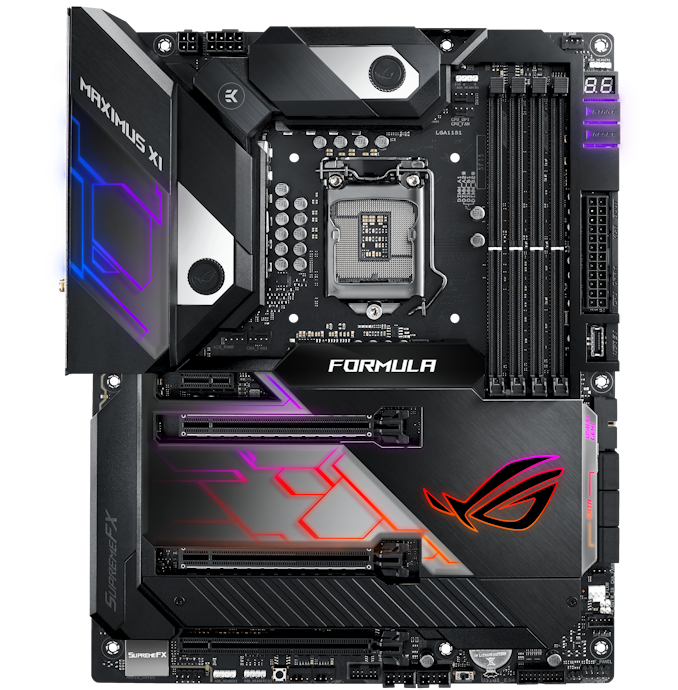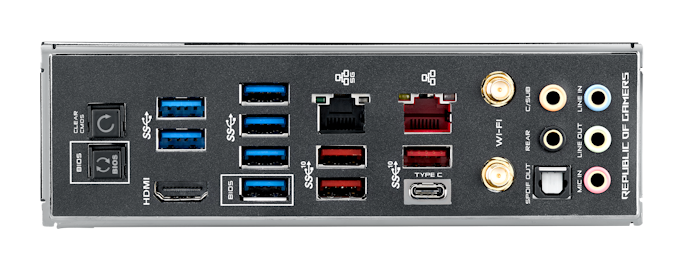Intel Z390 Motherboard Overview: 50+ Motherboards Analyzed
by Ian Cutress & Gavin Bonshor on October 8, 2018 10:53 AM EST- Posted in
- Motherboards
- Intel
- MSI
- Gigabyte
- ASRock
- EVGA
- Asus
- NZXT
- Supermicro
- Z390
ASUS ROG Maximus XI Formula
Another high-end board on the Z390 chipset from ASUS is the ROG Maximus XI Formula which has a similar rear panel cover as the Maximus XI Code along with what looks to be a near identical PCIe slot layout. Other similarities stretch to the use of a PCB cover which looks to have a little more flair and more RGB than the Code, but from a quick glance, the entirety of what's visible PCB wise looks to be identical to the ROG Maximus XI Code; this is not necessarily a bad thing. The biggest difference and impressive inclusion on the Formula over the Code is the EKWB power delivery water block which allows enthusiasts to hook it up to custom water cooling loops for even lower VRM temps; perfect for users to overclock their processors and NOT have to worry about the quality of the power delivery heatsinks.
The Maximus XI Formula keeps the same power and reset buttons with a LED debug in the top right corner. There are four RAM slots with support for DDR4-4400 with a maximum capacity of up to 64 GB in total. Built-in into the board is a pair of PCIe 3.0 x4 M.2 slots (one with SATA support and one without) which feature a pair of heatsinks which amalgamate into the boards overall aesthetic. Also present is a total of six SATA ports with support for RAID 0, 1, 5 and 10 arrays.
The board has three full-length PCIe 3.0 slots which allow for two-way SLI and three-way CrossFire multi-graphics card support at x16/x0/x4 and x8/x8/x4 respectively much like the majority of the Maximus XI boards including the Hero, Hero (Wi-Fi) and Code. This also stretches to the onboard audio and networking with a Supreme-FX S1220 8-channel HD audio codec and a single Intel I219V Gigabit NIC on the rear panel.
With a host of quality connections integrated, there's dual LAN with one port being powered by an Aquantia AC111C 5 G NIC and the second by an Intel I219V Gigabit controller. Wireless networking is provided by a Wave 2 2T2R 802.11ac Wi-Fi adapter and a single HDMI 1.4b video output. The same pair of buttons consisting of a BIOS Flashback and clear CMOS is featured much like the Code, and the onboard audio is controlled by a gaming-focused SupremeFX S1220A HD audio codec. Last but not least is USB support, with three USB 3.1 Gen2 Type-A ports, a single USB 3.1 Gen2 Type-A port and a hefty six USB 3.0 Type-A ports completing a packed rear IO.
The ASUS ROG Maximus XI Formula has an unknown price as of yet, but is one of the top ASUS Z390 boards at launch with a clear focus on gaming based features and enthusiast grade components such as the EKWB made power delivery heatsink. The Formula is primarily targeted at gamers and enthusiasts with overclocking as a focus and the inclusion of 5 Gigabit LAN sets this board apart from the most of the Maximus XI range.












79 Comments
View All Comments
pawinda8 - Monday, October 15, 2018 - link
Still no mention of any Z390 boards with native Thunderbolt 3 (not AIC)! Has Intel given up on Thunderbolt for the PC world?gavbon - Monday, October 15, 2018 - link
If it's not integrated into the chipset, it's not really native as such. The ASRock Z390 Phantom Gaming-ITX/ac has a Thunderbolt 3 port on the rear panel, but that's the only one I'm afraidHikariWS - Monday, October 15, 2018 - link
Oculus Rift requires 3 USB3 ports and doesn't accept any of them being connected to a hub, they all need to be connected directly into a raw port. I had to buy a dedicated 3GIO USB 3 board that added 6 useful extra ports. In my (yes, old) Gigabyte z87 mobo I also had issues using keyboard and mouse on USB 3 ports inside UEFI and some recovery softwares, so I had to buy a USB 2 mirror to connect them.Because of that, having USB 2 ports on front panel and nice quantity of USB 3 is what most differs mobos for me, given that all other features are nearly the same.
ASUS Z390-A seems to be the best option. It has the important double USB2 ports, 5 USB3 ports and still has HDMI and DP for emergencies.
just4U - Monday, October 15, 2018 - link
I wish MSI had released a "godlike" board for the Ryzen series.ThugEsquire - Tuesday, October 16, 2018 - link
You list the ASRock Z390 Phantom Gaming-ITX/ac above as an ATX board, but it's actually mITX. FYIgavbon - Friday, October 19, 2018 - link
I have gone through every page where the Phantom Gaming-ITX/ac is listed, but I can't see where it says it's an ATX board? Could you please be more specific? Are you viewing on mobile or desktop?Galcobar - Tuesday, October 16, 2018 - link
It would be really helpful to break out one more criteria into a table: Type-C header for case-front ports.Helping a friend put together an i5 system and, knowing he'll keep it for a long time, am trying to get even with peripheral connectors (already has a monitor, so no using that as a hub). It's relatively easy to identify cases with a Type-C port, but that's pointless without a motherboard header. Having to go into each board's page to check is time-consuming.
jjnam - Thursday, April 18, 2019 - link
6 months later and I'm here for EXACTLY this reason. I've gone through probably 50 manuals over the past few days squinting to find this information. What a pain.Synomenon - Thursday, October 18, 2018 - link
So on the ASRock Z390 Phantom Gaming-ITX/ac, is the TB3 port on the rear using up lanes from CPU (making the only 16x slot, 8x only)?If it's not using lanes from the CPU, how will using that TB3 port (say with a USB3.1 Gen2 hub OR TB3 hub) affect all the other ports / IO on the board?
repoman27 - Thursday, October 18, 2018 - link
Going off of what TweakTown published, it's a single-port Intel JHL6240 "Alpine Ridge" controller with a PCI 3.0 x2 connection to the PCH. So it won't affect the PEG lanes from the CPU. I'm amazed it's not Titan Ridge at this point though.